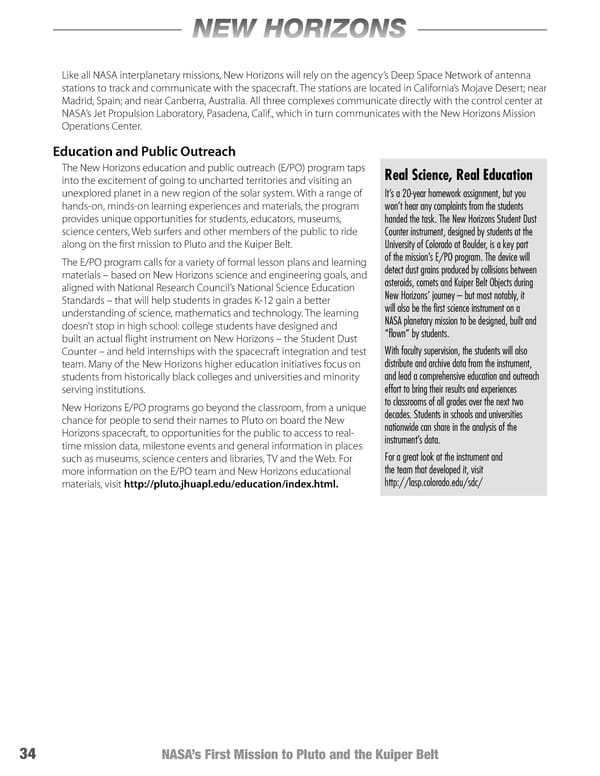NEW HORIZONS Like all NASA interplanetary missions, New Horizons will rely on the agency’s Deep Space Network of antenna stations to track and communicate with the spacecraft. The stations are located in California’s Mojave Desert; near Madrid, Spain; and near Canberra, Australia. All three complexes communicate directly with the control center at NASA’s Jet Propulsion Laboratory, Pasadena, Calif., which in turn communicates with the New Horizons Mission Operations Center. Education and Public Outreach The New Horizons education and public outreach (E/PO) program taps Real Science, Real Education into the excitement of going to uncharted territories and visiting an unexplored planet in a new region of the solar system. With a range of It’s a 20-year homework assignment, but you hands-on, minds-on learning experiences and materials, the program won’t hear any complaints from the students provides unique opportunities for students, educators, museums, handed the task. The New Horizons Student Dust science centers, Web surfers and other members of the public to ride Counter instrument, designed by students at the along on the first mission to Pluto and the Kuiper Belt. University of Colorado at Boulder, is a key part The E/PO program calls for a variety of formal lesson plans and learning of the mission’s E/PO program. The device will materials – based on New Horizons science and engineering goals, and detect dust grains produced by collisions between aligned with National Research Council’s National Science Education asteroids, comets and Kuiper Belt Objects during Standards – that will help students in grades K-12 gain a better New Horizons’ journey – but most notably, it understanding of science, mathematics and technology. The learning will also be the first science instrument on a doesn’t stop in high school: college students have designed and NASA planetary mission to be designed, built and built an actual flight instrument on New Horizons – the Student Dust “flown” by students. Counter – and held internships with the spacecraft integration and test With faculty supervision, the students will also team. Many of the New Horizons higher education initiatives focus on distribute and archive data from the instrument, students from historically black colleges and universities and minority and lead a comprehensive education and outreach serving institutions. effort to bring their results and experiences New Horizons E/PO programs go beyond the classroom, from a unique to classrooms of all grades over the next two chance for people to send their names to Pluto on board the New decades. Students in schools and universities Horizons spacecraft, to opportunities for the public to access to real- nationwide can share in the analysis of the time mission data, milestone events and general information in places instrument’s data. such as museums, science centers and libraries, TV and the Web. For For a great look at the instrument and more information on the E/PO team and New Horizons educational the team that developed it, visit materials, visit http://pluto.jhuapl.edu/education/index.html. http://lasp.colorado.edu/sdc/ 34 NASA’s First Mission to Pluto and the Kuiper Belt
 New Horizons Page 43 Page 45
New Horizons Page 43 Page 45